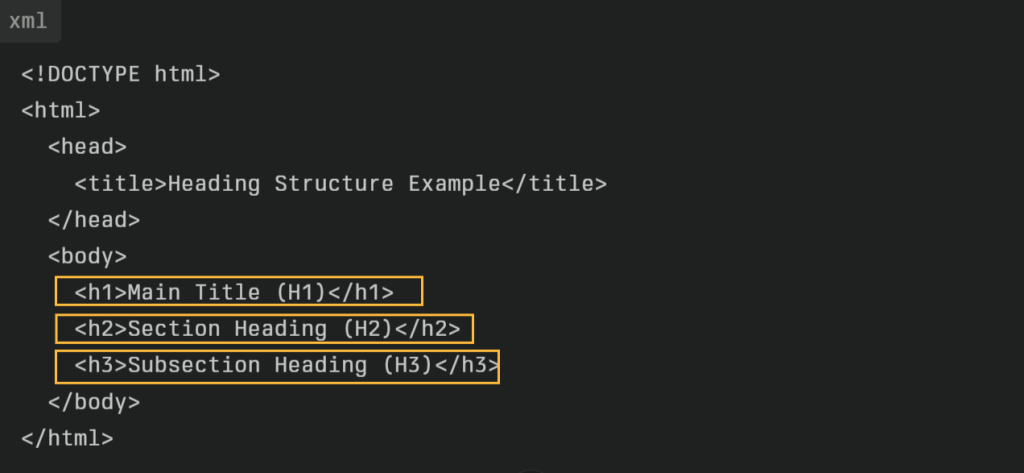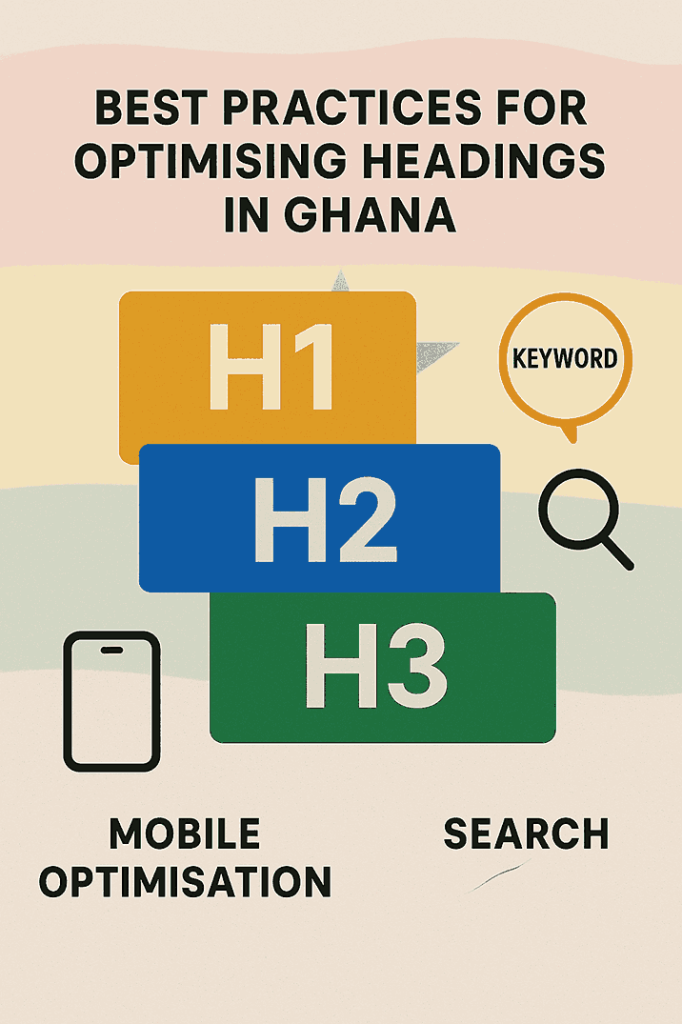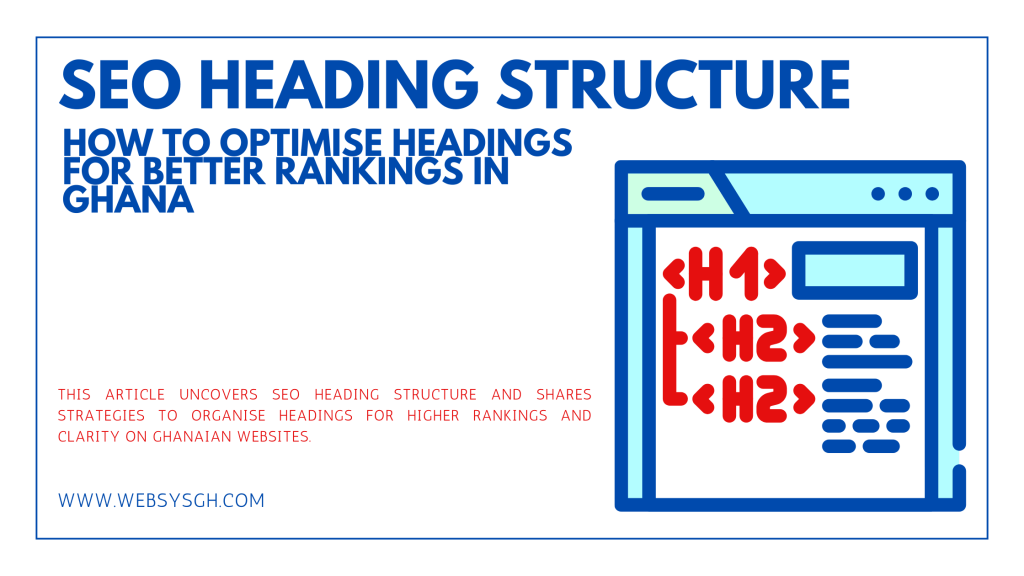Have you ever stared at your web analytics wondering why your website just doesn’t rank as high as you want? Maybe you tried writing better content or adding more keywords, but nothing sticks on Google’s first page.
Did you ever consider whether your headings follow Google’s guidance for effective SEO? If not, you’re missing out on one of the easiest gains in search rankings and user experience (UX). In this guide, you’ll learn why SEO Heading Structure makes or breaks your Ghanaian website performance.
You’ll discover how to optimise heading tags, build a strong page hierarchy, and boost both readability and rankings. Stick around, and by the end, you’ll have a clear plan to transform your site’s visibility and engagement.
What Are SEO Headings (H1, H2, H3, etc.)?
Imagine picking up a textbook. You flip through and see big, bold chapter names, subtopics, and smaller sections. That’s how headings work, but online. In web design, header tags are known as HTML tags (H1, H2, H3, H4, H5, H6). These define your content structure, making content skimmable and easy to explore.
H1 tags are like a book’s main title—used once per page for the central theme. H2 and H3 organise topics beneath the H1, showing page hierarchy. Lower tags, like H4 or H6, break content further if needed.
Here’s a simple HTML sample that shows the correct way to structure headings for SEO clarity using H1, H2, and H3 tags

Why does it matter? Well, search engines rely on these cues for determining main themes, context and key topics. Headings give semantic signals to crawlers. On the flip side, users scan bold headings to get a content preview and jump to what matters. You want to minimise confusion and keep both humans and crawlers happy.
Proper structure—clear mini titles, logical flow, concise headings—means easier navigation for everyone. This isn’t just theory. Ghanaian business website SEO relies on these principles to outperform the competition.
Why Heading Structure Matters for SEO in Ghana
A strong heading structure SEO isn’t just about looks. It’s about how your page communicates with Google, and importantly, with your audience. Headings shape crawlability and influence how search engines index the page. They improve readability, turning a block of text into a scannable article.
In Ghana, where digital competition is rising, search visibility depends on easy to understand content. Logical structures help crawlers identify ranking signals—making sure you’re not just found, but chosen. If you want to rank pages with lasting power, focus on your headings in your SEO strategy.
Google’s guidance, supported by experts like Google Search Advocate John Mueller, continually stresses the role of semantic, clear headings for both bots and readers. According to recent findings, most page one results have their primary keyword right in the H1 or title—clear proof that this matters for SEO in 2025.
For local businesses, good heading structure enhances user experience, keeps dwell time high, and can help reduce bounce rates. Proper headings mean users stay longer, navigate better, and engage more, essential goals for any Ghanaian website.
Best Practices for Optimising Headings in Ghana
To construct a winning content hierarchy, you need more than a few bolded titles. Let’s explore the SEO headings best practice that helps Ghana businesses rise above. Start by seeing your page as a story. Logical structure should guide both readers and crawlers from start to finish. Now, let’s look at the rules.

Use Only One H1 as the Page’s Main Topic
Your H1 tag signals the core subject—it stands alone. Only one H1 per page avoids mixed signals and guides both humans and bots. For example, on a page about eCommerce in Accra, a good H1 might be: “Affordable eCommerce Solutions for Ghanaian Businesses.” Place your primary keyword in this unique page title.
Stick to one H1 to keep your message focused. Google’s advice lines up here—multiple H1 tags can lead to weaker search rankings and confused visitors. Use H1 with confidence as your anchor.
Use Subheadings (H2, H3) to Create Logical Sections
Think of your H2 and H3 tags as chapters and sub sections—tools to break up text and bring structure. Each section targets a key topic or question, often aligning with popular search queries in your industry.
Short, descriptive subheadings help users find answers fast. They help with skimmable content, better navigation, and improved readability. Divide long explanations with bullet points or numbered lists to enhance scannability.
Include Keywords Naturally in Headings
Strategic keyword optimisation in headings drives search rankings. Don’t just dump keywords, though. Blend primary and secondary keywords without affecting flow. For example, use “Web design trends for Ghana” instead of “Web Design Ghana Ghanaian Web Design Best Ghana Web”.
Target long tail keyword phrases like “Cost of digital marketing in Ghana?”. Such phrases boost context while preventing keyword stuffing. Strong headings boost your page hierarchy and clarify content strategy.
Optimise for Featured Snippets & Voice Search
Featured snippets and voice search form the new SEO frontier. Google scours for concise, clear answers—often in well labelled, structured headings and paragraphs. To win snippets, use headings with direct answers underneath. That’s how you reach “position zero” in the SERPs.
Bulleted or numbered lists under a relevant H2 can appear in list featured snippet boxes. For a paragraph featured snippet, offer a neat summary below an information rich heading. Snippets drive high engagement rates and pull visitors to your page.
Keep Headings Clear, Not Just Keyword-Stuffed
Resist cramming every heading with keywords. Instead, clarity and mini titles should guide your choices. Use informative headings that preview each section. If the reader sees “How to set up Office Network in Ghana,” they know what comes next.
Google’s algorithms reward content that avoids keyword stuffing, favouring natural flow and high quality user experience. The more readable and authentic, the bigger the SEO win.
Ensure Consistency Across Headings
Branding consistency means headings match your company’s style and voice. Use consistent formatting, similar tone, and even case (sentence or title case). Maintain logical heading structure—don’t jump from H1 straight to H4.
When headings look and feel united, readers trust you more. Search engines appreciate it too, seeing clear relationships between sections, aiding better indexing and ranking.
Make Headings Engaging to Improve Dwell Time
Compelling headings do more than inform—they invite readers to stay and explore. Use engaging headers that spark curiosity or answer burning questions. “Is Your IT Support Ready for Ghana’s Digital Future?” grabs attention more than “IT Support”.
Craft mini titles that stand out. Engaged visitors mean longer dwell time, reducing bounce rates and signalling SERPs that your content is worth ranking high.
Common Mistakes to Avoid in Heading Optimisation
Before you charge ahead, watch out for these easy pitfalls. Mistakes can weaken your SEO performance or confuse your audience:
- Using more than one H1 tag per page
- Skipping heading levels (going from H1 to H3)
- Stuffing headings with too many keywords
- Using headings only for visual effect, not meaning
- Writing vague or generic headings that lack information
- Making headings overly long—brevity works better
- Ignoring accessibility, which impacts users with screen readers
- Adding unnecessary headings just to fill space
Each mistake impacts SEO, readability, or both. Use Screaming Frog (tool) to analyse your site’s HTML tags structure and catch these pitfalls early. Stay proactive in optimising header tags.
How Heading Optimisation Impacts Local SEO in Ghana
Local SEO is a battle for attention in a crowded digital market. Optimising your SEO heading structure gives you an edge over bigger brands—especially when you tailor content structure for the Ghanaian audience.
First, optimised headings make your page hierarchy more obvious. Search engines can rank pages more effectively, and human visitors experience improved readability. Featured snippets often showcase clear sections from local businesses, amplifying their visibility and authority.
Secondly, keyword rich headings match what users in Ghana actually search. Use real life Ghanaian city names, local industry terms, and region specific pain points in both H1 and supporting tags. Your site will not only index properly but also grab attention from searchers looking for nearby services.
Finally, well written subheadings encourage better navigation, minimising bounce rate and keeping visitors engaged. That means higher SERP ranking and more business for you.
Read more: What Are the SEO Services Misconceptions in Ghana?
Step-by-Step Example of an Optimised SEO Heading Structure
Let’s walk through a real example. Imagine a digital branding service page for Accra:
- H1: Digital Branding Services for Accra Entrepreneurs
- H2: Why Digital Branding Matters in Ghana
- H3: Build Trust With a Consistent Brand Identity
- H3: Go Beyond Logos—Deliver Compelling Headings & Visuals
- H2: How Our Branding Strategy Drives Results
- H3: Tailored Content Strategy for Ghanaian Markets
- H3: How to Boost Engagement Rates Using Header Tags
Notice the flow. Each heading supports the next. Secondary keywords like “branding consistency” and “compelling headings” show up naturally. The structure mirrors how users navigate and how crawlers assess relevance for search visibility.
Pro Tip: Always check the structure with Screaming Frog or similar crawlers. Make sure all HTML tags serve a real purpose.
Read more: A Complete Guide to Website Optimisation in Ghana
Recap
A strong SEO heading structure is the backbone of site success in Ghana. Start with a single, targeted H1. Support with logical, keyword optimised subheadings. Keep headings clear, concise, and engaging. Minimise mistakes by staying vigilant and adapting to user needs and Google’s changing algorithms.
Remember, optimised headings are not just boxes to tick off. They’re powerful tools—raising clarity, enriching UX, and pushing you up the SERPs. Stick to these best practices, and you’ll see growth in traffic, rankings, and conversions.
Need professional Assistance? WebSys Technology is Here
Rely on WebSys Technology’s local expertise for real results:
- Ghana focused web design and content structure mastery
- Proven SEO heading structure for first page Google rankings
- Consistent branding and user experience designed for conversions
- Fast, affordable digital solutions for Ghanaian businesses
With a strategy tailored for the Ghana market, we guide your online presence to its full potential.
GET IN TOUCH
Book a Free Meeting!
What Our Clients Say About Us?
Their digital solutions have transformed our online presence! From SEO to social media marketing their strategies have significantly boosted our customer engagement and sales_Ama Owusu Djan
I’m impressed with how professional and reliable their IT support is. Whenever we face challenges, their tearn is always available to help. They’ve become an indispensable part of our business operations_Justine Akosua Nyarko

